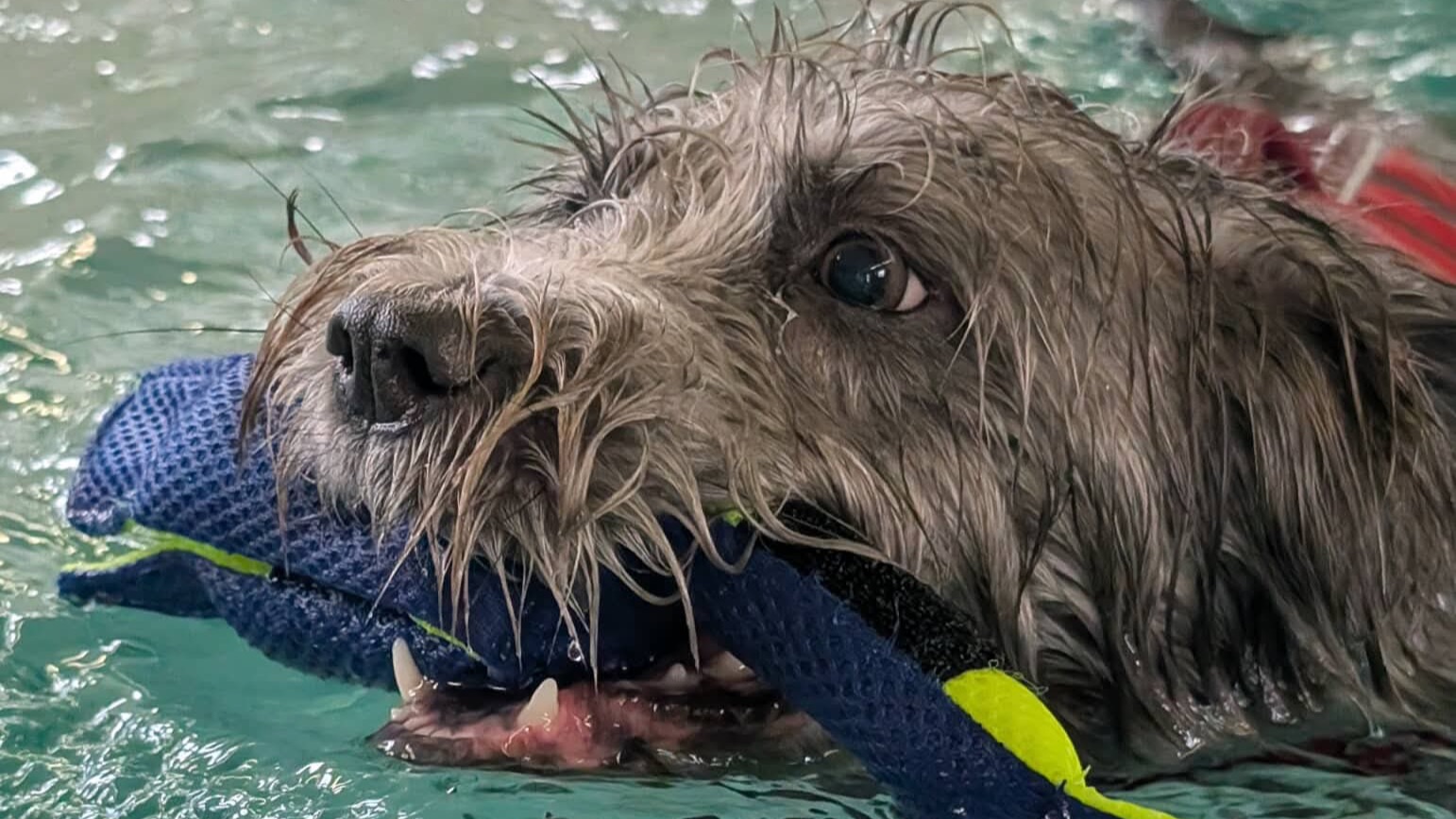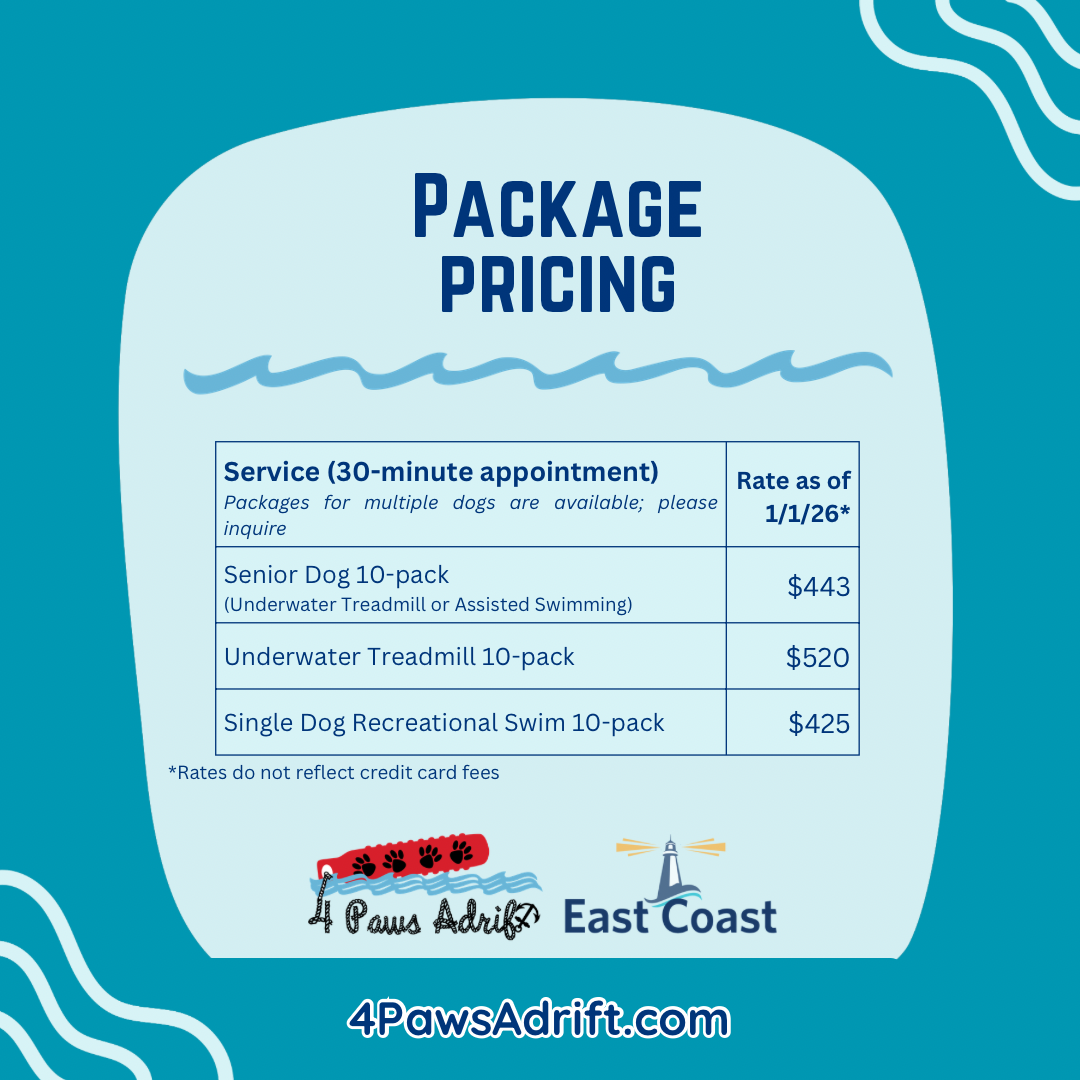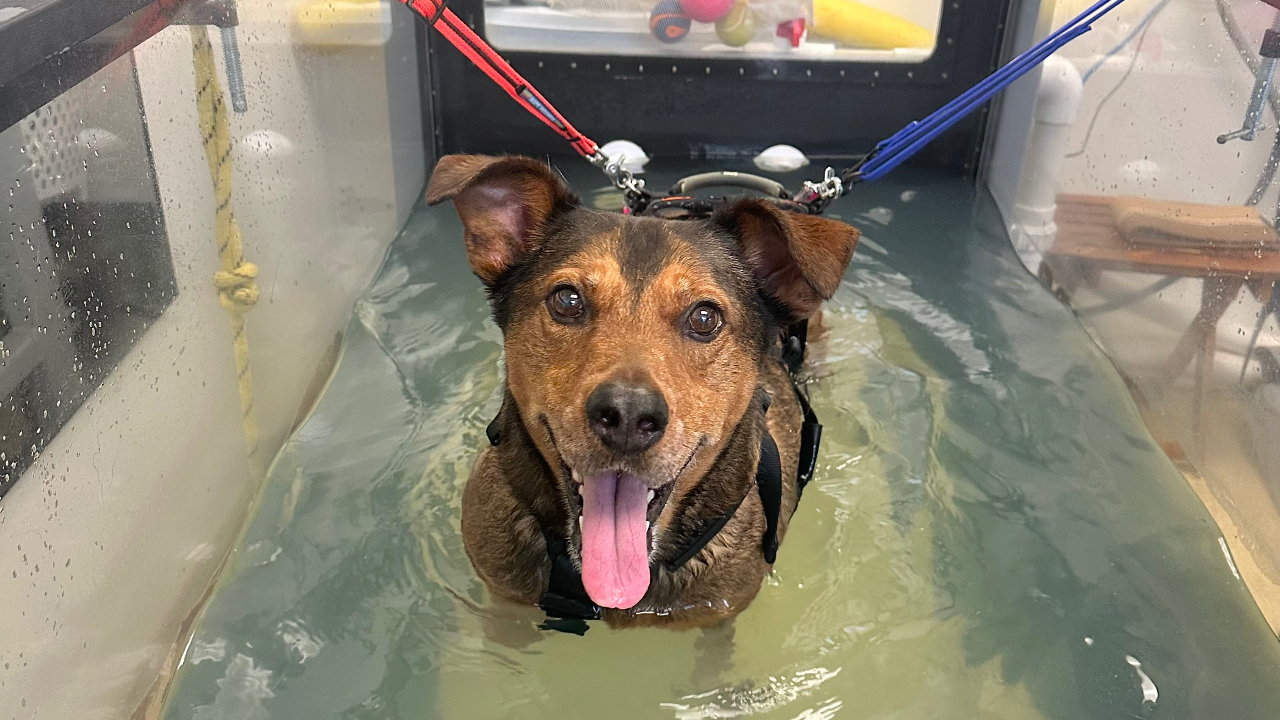Welcome to 4 Paws Adrift East Coast!

Welcome to 4 Paws Adrift East Coast!
My mission when creating our swim program was to establish a place where people can afford long-term hydrotherapy for their senior or injured dog. We have since expanded the program to teach dogs of all ages the joy of swimming, and we take pride in providing a relaxing and safe environment so your furry family member can have the best life possible!
Our lovely swim center in Allentown, NJ features an indoor heated saltwater pool, an underwater treadmill, and a high-powered PEMF device. We have learn-to-swim, recreation, conditioning, senior dog, and rehabilitation programs.
All new clients start with an evaluation with our certified and experienced swim coaches. After the evaluation, your swim coach will guide you as to which program meets your and your pup’s needs.
Many clients take advantage of our package program, which offers 10% off when you buy a 10 pack.

We also encourage clients who want to keep their dogs on a regular schedule of ...
How to Boost Your Dog’s Kibble: 5 Simple Add-ins to Enhance Every Bowl

How to Boost Your Dog's Kibble: 5 Simple Add-ins to Enhance Every Bowl
Written by: Alexis Egnatovich
Feeding time is an opportunity to not only nourish your dog, but support their overall health, happiness and well-being. While high-quality kibble can provide a solid nutritional foundation, many dogs benefit from a little extra boost in their bowls. By adding fresh, functional, and wholesome ingredients, you can make mealtime more exciting, enhance nutrition, and even help ease the transition if you ever decide to explore a fresh food diet.
Here are five easy ways to enhance your dog’s kibble, making every meal more delicious and nutrient-rich.
1. Bone Broth
Bone broth is a powerhouse of nutrients. Bone broth is typically made by simmering bones, tissue, and herbs (which is something you can even make at home). Bone broth is naturally rich in:
- Glucosamine – supports joint health and mobility
- Chondroitin – helps maintain healthy cartilage
- Collagen – promotes skin, coat, and ...
The Gift of Teaching Your Dog to Swim

The Gift of Teaching Your Dog to Swim
By Chrissy Poth, CPDT-KA, KPA CTP, FFCP
When Jack was just 14 weeks old, he was curious about water but found it . . . well, suspicious. He’d look at lakes, streams, and puddles with that mix of fascination and hesitation only a puppy can pull off. I made it my mission to change that.
Every week, we explored a different kind of water—a calm lake one day, a babbling creek the next, and even the shallow end of a pool. With the help of Erica, we made every interaction positive, turning splashes into fun instead of fear. Slowly but surely, Jack’s confidence grew.
Then, finally, at nine months old something magical happened. While we were at the lake, he spotted a kayak gliding across the water. His curiosity finally outweighed his caution. He gathered every ounce of puppy courage, paddled out, and swam for the very first time. From that moment on, there was no stopping him. Jack became the kind of dog who would happily drag me toward the water at ...
The Water Table: Your Secret Weapon for Teaching Your Dog to Swim Joyfully

The Water Table: Your Secret Weapon for Teaching Your Dog to Swim Joyfully
Written by: Erica Etchason, owner 4 Paws Adrift and Dremel Like a Boss
Swimming is often one of our favorite activities to offer our dogs, whether for recreation, sport, or conditioning. 4 Paws Adrift was built on teaching dogs to swim. I started swimming dogs to spend more time outside in beautiful lakes with my dog by my side, and it brought me so much joy that I wanted to share it with other people.
The Challenge: Teaching Dogs to Swim with Joy
Some dogs take to the water like fish and some do not. I recognized pretty quickly that people wanted their dogs to enjoy the water even if it didn’t come naturally. My mentor, Deborah Lee Miller-Riley, created a platform that allows dogs to put their feet down in the water while learning to swim.
This was a game changer for all of us. More and more dogs, of all breeds and ages and at all levels, were successfully swimming and learning to enjoy the water.
What is...
Kidney Care for Dogs: Nutrition and Support Tips

Kidney Care for Dogs: Nutrition and Support Tips
Written by: Alexis Egnatovich
Our dogs rely on us for everything from food to exercise. One of the most important, yet often overlooked, aspects of their health is kidney function. The kidneys play an essential role in their bodies (and ours). When the kidneys aren’t functioning properly, it can have serious implications. That’s why it’s so important for pet parents to understand the signs of kidney trouble and the steps they can take to support healthy kidney function.
The Importance of Your Dog’s Kidneys
The kidneys are part of your dog’s renal system and are responsible for:
- Filtering waste and toxins from the blood
- Balancing fluid and electrolytes
- Regulating blood pressure
- Producing hormones that support red blood cell production
- Maintaining healthy pH levels in the body
Healthy kidneys perform these vital tasks every day, but when the kidneys are damaged or begin to decline, the entire body is impacted. Dogs may sho...
Which Slow Feeder Is Right For Your Dog?

Does your dog eat meals so quickly that they make themself sick? Are you concerned about the possibility of bloat? Or, does your dog simply need more enrichment when you have a busy day? Slow feeders can be helpful in all of these situations. These bowls and mats have different obstacles to encourage dogs to eat their meals more slowly and thoughtfully, reducing the risk of bloat, gas, choking, and vomiting.
When choosing a slow feeder bowl or mat for your dog, there are several points to consider.
- Many types are quite difficult for dogs with short muzzles. They are unable to get to all of the food and can become discouraged.
- They can be time-consuming for humans, too! Most require supervision, so if you have a busy schedule, you may not have time to wait for your dog to be finished with many of the more difficult ones.
- Some types can be difficult to clean. Not all are dishwasher safe, or they may have grooves that trap bits of food. Fabric ones may need to be cleaned in a was...
Is your scratchboard enough for a well-rounded nail care routine?
Nail care maintenance for our canine companions comes in a few flavors. My first choice, and the one around which I built my signature course, is the Dremel. If you do not have a sound-sensitive dog, this tool with a Diamagroove bit is the gold standard.
When owners and their dogs struggle with nail care, most veterinarians and dog trainers recommend using a scratchboard. This is a great tool to get your dog started, but this method has some issues you need to watch out for. Owners need to be careful the dog’s pads are not getting injured. You should be inspecting the feet and nails regularly if you are using this method. You may notice that the nails may be filed unevenly. Some toes may be near the quick; while others may not be filed enough. You need to especially be concerned with the middle two nails on the front feet. Those can be hard to get filed using a scratchboard.
In my program, Dremel Like a Boss, when we realize the Dremel is not an option for a dog, we talk about manual...
How to be successfull with Dog Cone Collars & Recovery Apparel
The video in this article is an example of training you can do with your pup to make the Elizabethan collar a non event for you and your pup.
This discussion came up with my Dremel Like a Boss students and I thought the topic was excellent as an article for all of you!
The question asked was about using pet recovery collars (AKA Elizabethan collars, e-collars, cones, etc.) and ideas on how to get our dogs used to it before a surgery. This is the mindset we want in the membership is how do we prepare our dogs for any husbandry procedure before it happens, instead of fixing it after it happens. We want to prepare our dogs for the event in the best way we can.
There are now many devices to allow our dogs to heal after surgeries. I will list some of them below:
- Recovery suits- great for many types of surgeries (especially spay/neuter surgery) as long as the suit covers the wound/incision and your dog won’t lick/chew through the suit. Make sure they are not too big. If your dog is bet...
Please add handling, restraint, and husbandry behaviors to your training plan. Small things will make a huge difference…trust me!

This topic has been hitting home for me lately and I really want to make sure as many people as possible take this topic to ❤️.
I currently live with four dogs part time and two of those dogs had lovely comments from professionals this week. Let me start with Jibe, although I have spent many hours training her on husbandry skills, these results can be achieved with a smaller commitment as you will see with Beckett’s story in a bit.
Jibe is a heavy-coated Newfoundland with a full on spay coat and heavy furnishings. We have run into an orthopedic issue that will likely require surgery, conservative management, and underwater treadmill. When Jibe was young, she was not comfortable with strangers. Our handler and many of my dear friends worked with Jibe to get her used to people other than her mama taking the end of her leash. As part of my Dremel Like a Boss program, we work on handling, chin rest, restraint and generalization of these behaviors for groomers and veterinarians.
A coup...
Do you travel for long periods with your dog? 🐕🦺🌎
I have been traveling and I am sometimes away for a month at a time. This means I need to do some grooming on the road with my Newfoundland, Jibe. If you do not have a double coated breed, your list will be shorter than mine, but anyone traveling for a bit with a dog needs a few things just in case. I wanted to make sure I had things for regular maintenance, but also in case I ran into burrs or mud and couldn’t give her a bath.
BTW I have run into burrs and needed quite a few things on this list. 🤣
Here is my list of must have grooming travel items for longer trips:
- Dremel - I use an actual Dremel with a DiamaGroove diamond bit from Whitman.
- Ear Cleaner- The Zymox line is one of my favorites. (Amazon Affiliate Link)
- Eye Wash - I just use sterile solution eye wash from the grocery store
- Hot Spot Treatment- Vetericyn is my favorite. (Amazon Affiliate Link)
- Rake/Comb- Livestock Comb. This is literally my favorite rake of all time. (Amazon Affiliate Link)
- Leave in Conditioner- I ...

